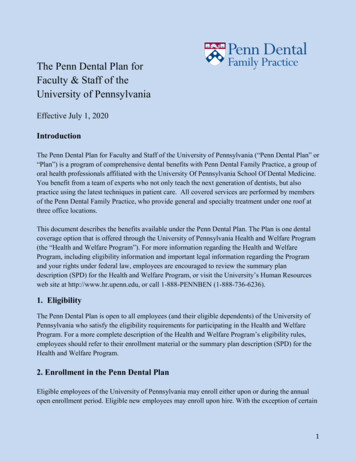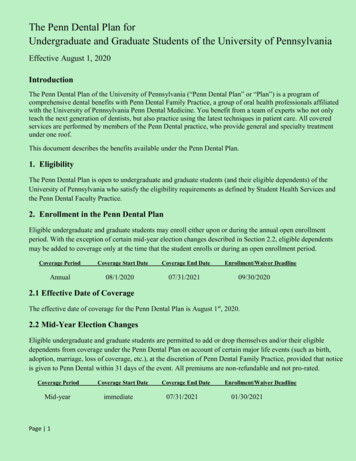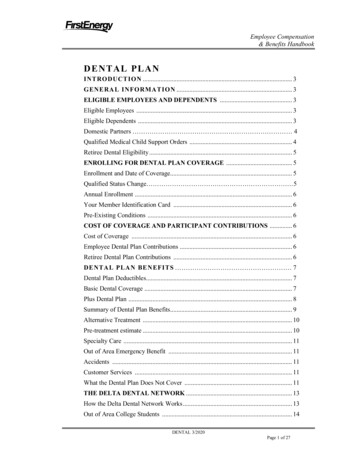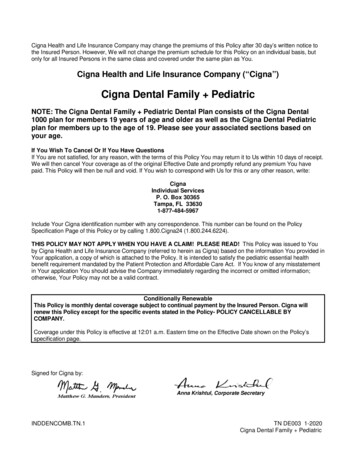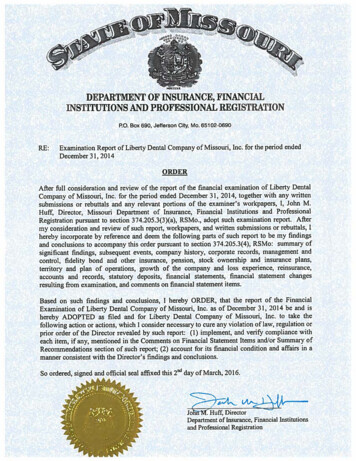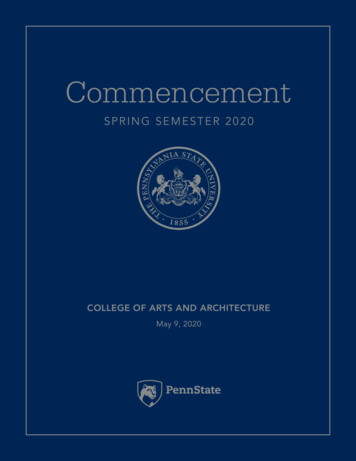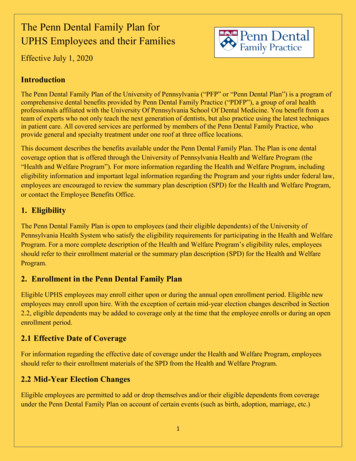
Transcription
The Penn Dental Family Plan forUPHS Employees and their FamiliesEffective July 1, 2020IntroductionThe Penn Dental Family Plan of the University of Pennsylvania (“PFP” or “Penn Dental Plan”) is a program ofcomprehensive dental benefits provided by Penn Dental Family Practice (“PDFP”), a group of oral healthprofessionals affiliated with the University Of Pennsylvania School Of Dental Medicine. You benefit from ateam of experts who not only teach the next generation of dentists, but also practice using the latest techniquesin patient care. All covered services are performed by members of the Penn Dental Family Practice, whoprovide general and specialty treatment under one roof at three office locations.This document describes the benefits available under the Penn Dental Family Plan. The Plan is one dentalcoverage option that is offered through the University of Pennsylvania Health and Welfare Program (the“Health and Welfare Program”). For more information regarding the Health and Welfare Program, includingeligibility information and important legal information regarding the Program and your rights under federal law,employees are encouraged to review the summary plan description (SPD) for the Health and Welfare Program,or contact the Employee Benefits Office.1. EligibilityThe Penn Dental Family Plan is open to employees (and their eligible dependents) of the University ofPennsylvania Health System who satisfy the eligibility requirements for participating in the Health and WelfareProgram. For a more complete description of the Health and Welfare Program’s eligibility rules, employeesshould refer to their enrollment material or the summary plan description (SPD) for the Health and WelfareProgram.2. Enrollment in the Penn Dental Family PlanEligible UPHS employees may enroll either upon or during the annual open enrollment period. Eligible newemployees may enroll upon hire. With the exception of certain mid-year election changes described in Section2.2, eligible dependents may be added to coverage only at the time that the employee enrolls or during an openenrollment period.2.1 Effective Date of CoverageFor information regarding the effective date of coverage under the Health and Welfare Program, employeesshould refer to their enrollment materials of the SPD from the Health and Welfare Program.2.2 Mid-Year Election ChangesEligible employees are permitted to add or drop themselves and/or their eligible dependents from coverageunder the Penn Dental Family Plan on account of certain events (such as birth, adoption, marriage, etc.)1
provided that notice is given to the Benefits Office and Penn Dental within 30 days of the event. Moreinformation about change in status events can be found in the SPD for the Health and Welfare Plan.3. Schedule of BenefitsThe Penn Dental Plan provides the following coverage:Type I Services – 100% Coverage Diagnostic and Preventive, including routine examinations and prophys/cleanings (limited to notmore than two times in a fiscal year July 1 through June 30), radiographs (excluding CBCT),fluoride applications and sealants (for children up to and including age 14), sealants covered 2times in 14 fiscal years on permanent molars only, excluding wisdom teeth, and oral hygienecounseling.Type II Services – 80-100% Coverage Basic restorations: Amalgam (silver-colored restorations) for back teeth and Composites (tooth-coloredrestorations) for front teeth cavities are covered at the 80% rate. Composites for back teeth cavities arecovered at 80%. Coverage is contingent upon radiographic evidence showing the need for the compositefor non-cosmetic purposes.Oral surgery (out of hospital only) including extractions, incision and drainage of abscesses,alveolectomy, and alveoloplasty, removal of oral cysts and tumors, and other routine oral surgicalprocedures performed in the office are covered at 90%. The aforementioned services shall be coveredby the Penn Dental Family Plan only if such services are not covered by the subscriber’s medicalcoverage. The Plan covers full and partial bony impacted third molars and the directly-related diagnosticexpenses, only if denied by medical coverage. Coordination of benefit rules apply and shall not exceed100% of the treatment cost.Emergency treatment (palliative treatment for the relief of pain or discomfort) is covered at 100%.Other services performed during emergency treatment will be covered at their usual benefit levels.Type III Services – 80% Coverage Periodontics: Surgical and non-surgical periodontics including subgingival curettage, scaling and rootplaning, periodontal maintenance.Endodontics, including pulp treatment, root canal therapy, pulpotomy, and apicoectomy.Type IV Services – 50-60% coverage Major restorations: including inlays, crowns (when necessary due to decay or fracture), and bridges arecovered at 60%.Dentures, including complete upper and/or lower dentures, partial dentures, and relining and repair ofdentures are covered at 60%.Space maintainers—prosthetic devices used in children to maintain the gap created by a missing toothuntil the permanent tooth emerges are covered at 50%.2
Implants: placement is covered at 50%. Restorations on implants, including crowns and otherprostheses, are covered at 60%. The implant abutment (post that is placed in the implant fixture andanchors the crown), bone graft, and any other biological materials are excluded from coverage. The Plan will only cover crown restorations for implants that were placed at Penn Dental.Please refer to section 3.3 for limitations and exclusions. This implant benefit will be applied to theannual maximum Plan benefit of 3,000.Occlusal Nightguards (processed in an outside laboratory or at Penn Dental) are covered at 50% and arelimited to 1 every 5 years.CT Scans for diagnostic purposes for dental procedures (when scanned at Penn Dental) are covered at50%. Please refer to the limitations and exclusions section.Type V Services – 60% coverage Orthodontics: includes one orthodontic treatment per lifetime for children and adults. Indications fororthodontics are an overbite of at least four millimeters, a crossbite, or protrusive or retrusiverelationship of at least one cusp. Transfer of subscribers under treatment will be subject to a monthlytreatment fee, which will be covered at the 60% level. Subscribers in treatment when their Penn DentalPlan coverage is no longer in effect will have their orthodontic benefit prorated by the time remaining intreatment, subject to a 2,000 lifetime maximum benefit.Invisalign is included in this orthodontic benefit, subject to the 2,000 lifetime maximum benefit.Subscribers must be a candidate for Invisalign as determined by Penn Dental.The orthodontic benefit will be applied towards the annual maximum Plan benefit of 3,000.3.1 Co-payments and DeductiblesFor Type II, III, and IV services, there is a 50 Plan year (July 1-June 30) deductible that applies. Themaximum deductible per individual per year is 50 or 150 per family. Co-payments are dependent on the typeof services provided and are due at the time of treatment. For specific co-payments, contact your Penn Dentaloffice.3.2 EmergenciesEmergency care is provided for subscribers of the Penn Dental Family Plan on a 24-hour basis. If an emergencyoccurs outside of normal business hours, the subscriber should call (215) 898-PDFP (7337) or any Penn Dentaloffice for a referral to the emergency provider on call.3.2.1 Out-of-the-Area Emergency CareIn the event that an emergency occurs when the subscriber is more than 100 miles away from one of the PennDental offices, palliative treatment (treatment to alleviate the immediate discomfort) from a non-plan dentist iscovered by the Penn Dental Plan. Examples of emergencies are pain, fever, swelling, bleeding, or loss of atooth.3
Treatment from a non-plan dentist should be limited to palliative treatment. Follow-up care must be providedby Penn Dental in order to be covered.To receive reimbursement from the Penn Dental Family Plan, the subscriber must submit an itemized bill withprocedure codes and receipt of payment from the dentist who provided the emergency treatment. If x-rays weretaken, they must also be included or forwarded electronically.The subscriber is responsible for all out of pocket expenses incurred for the emergency care treatment. Thesubscriber shall receive reimbursement from the Penn Dental Family Plan for the palliative emergency servicesat a rate equal to the Penn Dental Family Practice fee for the same or similar service, subject to the Plancoverage and limitations. The subscriber is responsible for any fees charged by the dentist who providedemergency treatment that are in excess of those charged by Penn Dental Family Practice.3.3 Limitations and ExclusionsThe maximum annual benefit per plan year (July 1-June 30) for each family member is 3,000.The Penn Dental Family Plan will NOT cover: An appliance or modification of one, where an impression was made before the subscriber was covered.Root canal therapy if the pulp chamber was opened before the subscriber was covered.Fixed prosthetics (including implants) and full or partial denture at any stage of fabrication prior tocoverage. In the case of out-of-area emergency treatment for these partially-completed procedures,coverage is subject to the approval of the Clinical Director.Other procedures not covered by the Penn Dental Family Plan include, but are not limited to, the following: Services, procedures, or supplies not provided by Penn Dental, except for emergency services coveredin Section 3.2.1.Services provided under any government program or law under which the individual is, or could be,covered as determined by the Penn Dental Plan Administrators.Coverage for a restoration (bridge, crown, removable denture or implant) of a tooth or teeth missing orextracted prior to enrollment in the Penn Dental Plan is subject to the approval of the Clinical Directorand may be denied.Unserviceable appliances that meet all of the other criteria for replacement will be replaced by sametype appliances or an alternative benefit for enhanced prosthetic choices can be applied at the discretionof the Penn Dental Plan Administrator.Replacement or upgrade of a previous restoration (bridge, crown, removable denture of implant) that isless than 60 months old. If the restoration was not performed in one of the Penn Dental offices, thesubscriber is responsible for obtaining documentation of the restoration’s age.Temporary provisional crowns.For implants that were placed by Penn Dental within the past five years, the Plan will not cover aremovable partial denture placed in the same immediate area.Occlusal appliances, other than for bruxism or any occlusal guard that is less than 5 years old.Procedures necessary to alter the vertical dimension or to restore occlusion by splinting.4
Splinting teeth with permanent restorations (crowns) for periodontal purposes.Services necessitated by an accident related to employment or disease covered under the workers’compensation or similar law.Abutments, bone grafts and biological materials, such as membranes, for dental implants (which must bepaid for before delivery of such materials).Prosthetic superstructure over implants (crowns, bridges, attachments, dentures) if the implant itself wasnot covered under the Penn Dental Plan).Replacement of lost or broken orthodontic appliances.Orthodontic appliances, including retainers are limited to 1 replacement every 3 years and are subject tothe 2000 lifetime orthodontic maximum.Oral surgery and related expenses in a hospital.Dentistry requiring hospitalization except preauthorized pediatric dentistry covered at Penn Dental Planlevel of benefits.General anesthesia—Conscious (IV or Oral) sedation—for dentistry services (i.e. fillings, extractions,etc.). For complex extractions, the Penn Dental Plan Office will submit to your medical carrier forcoverage.Treatment of temporomandibular (TMJ) dysfunction. No TMJ appliances.Dentistry primarily for cosmetic purposes.A service provided while the subscriber’s coverage is not in effect, except as provided under Section5.1.Nitrous oxide.Preventive sealants on adults are not covered. Sealants are covered to age 14 only and are limited tocoverage 2 times in 14 fiscal years on permanent molars only and exclude wisdom teeth.Fluoride treatments for subscribers 15 years of age and older.Oraquix (needle-free anesthetic) tissue anesthesia.Whitening procedures.4. Cost of CoverageSubscribers are expected to pay their share of the cost of services, if any, at the time of their visit.Arrangements can be made with the billing staff for individual payment plans, such as those for crown andbridge treatment and orthodontics.4.1 Employee ContributionEmployees should refer to their enrollment materials for information on what, if any, employee contribution isrequired for coverage under the Penn Dental Plan. Contributions are deducted from pay before any federalincome tax; FICA (Social Security) tax and Medicare Insurance tax are withheld. The state tax treatment willdiffer from state to state. There are exceptions to the pre-tax status of your contributions for a same-sex partnerand a partner’s child(ren) who are not your tax dependents. See the SPD for the Health and Welfare Plan formore information about these special situations.5. Termination of Coverage5
In general, coverage for the subscriber and family members will terminate if the subscriber ceases to be aneligible employee of the University of Pennsylvania Health System or if the Penn Dental Plan is discontinuedby the University of Pennsylvania Health System. More detailed information about when and how coverageunder the Penn Dental Plan may end is set forth in the SPD for the Health and Welfare Plan.5.1 Extension of BenefitsIf coverage under the Penn Dental Plan is terminated for the subscriber or a family member, the protection willbe extended to cover treatment in progress or basic services received within the next 30 days provided that theseservices would have been covered had the Penn Dental Plan remained in effect. Payment for treatment receivedafter this extension period will be on a fee-for-service basis.6. Subscriber ResponsibilitiesSubscribers to the Penn Dental Plan are expected to: Seek all dental care from Penn Dental Family Practice (this Plan is not accepted at the School of DentalMedicine student clinics).Pay deductibles and their co-payments for covered services at the time of the visit.Notify the Benefits Office of any changes in status affecting covered dependents.Request treatment plan recommendations in a printed format.Give at least 24 hours’ notice for cancellation of appointments. If a subscriber or his/her dependents failto give advance notice (minimum 24 hours), a letter will be sent notifying the subscriber that futurefailed or broken appointments (less than 24 hours) will generate a fee. This fee will increase with futurefailed or broken appointments. Subscribers must pay all failed or broken appointment fees beforescheduling future appointments for dental treatment.Notify their provider at their next appointment of any changes in medical history, including medications.Be present for the entire visit when a minor child is having dental treatment and sign a treatment plan forthe child.Be on time for all appointments.Maintain good dental health habits.7. Changes in Family StatusNotify the Benefits Office of any changes in family status affecting covered dependents.8. Coordination with Other PlansThe Penn Dental Plan contains a provision that coordinates the benefits it pays on behalf of an individual withpayments that may be made under other plans covering the individual so that the total benefits available will notexceed 100% of the allowable expenses.An allowable expense is any necessary, reasonable, and customary expenses covered, at least in part, by one ofthe “plans.” For this purpose, the terms “plans” refer to the following types of medical and dental care benefitprograms: (a) coverage under a government program or coverage required by statute, including no-faultcoverage to the extent required in policies or contracts by a motor vehicle insurance statute or similar6
legislation; and (b) group insurance through employment or other coverage obtained through an educationalinstitution above the high school level.When a claim is made, the primary plan pays its benefits without regard to any other plans. The secondary plansadjust their benefits so that the total benefits available will not exceed the allowable expenses. The Penn DentalFamily Plan will not pay more than it would have paid if there was no other plan. A plan without a coordinationprovision is always the primary plan. If all plans have a coordination provision, the plan covering the subscriberdirectly, rather than as a dependent, is the primary plan. If both parents cover a dependent child, except forsituations where the parents are separated or divorced, the plan of the parent whose date of birth (month, day)falls earlier in the calendar year is the primary plan for that child. If both parents have the same birth date, theplan that covered the parent longer shall be primary.9. Statement of Rights of UPHSAs with any other coverage option provided under the Health and Welfare Plan, UPHS (acting through itsExecutive Committee or a duly authorized delegate) reserves the right to amend or terminate the Penn DentalPlan, in whole or in part, at any time.10. Resolution of Questions Regarding Services and BillingIf a subscriber believes that he/she has not been provided with sufficient information about the Penn DentalFamily Plan or has been denied a benefit under the Penn Dental Family Plan, the subscriber may file a writtenclaim with:Penn Dental Plan Administrator240 S. 40th StreetSchattner Building – Suite 300Philadelphia, PA 19104askPDFP@dental.upenn.eduDetailed information about filing claims and appealing denied claims for benefits under the Penn Dental Plan isset forth in the SPD for the Health and Welfare Plan.11. Miscellaneous InformationPlan Administrator:The Associate Vice PresidentHuman ResourcesHospital of the University of Pennsylvania3400 Spruce StreetPhiladelphia, PA 19104(215) 615-2675Plan Year:The Plan year begins each July 1st and ends June 30th.7
The Penn Dental Family Plan for . UPHS Employees and their Families . Effective July 1, 2020 . Introduction . The Penn Dental Family Plan of the University of Pennsylvania ("PFP" or "Penn Dental Plan") is a program of comprehensive dental benefits provided by Penn Dental Family Practice ("PDFP"), a group of oral health


